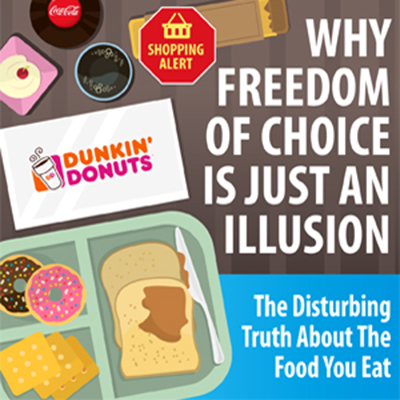 Standing in the supermarket’s food section aisle you’re confronted with hundreds of different products compounded by the happy proliferation of subcategories. You have a wide choice of grocery items at your fingertips. Or have you?
Standing in the supermarket’s food section aisle you’re confronted with hundreds of different products compounded by the happy proliferation of subcategories. You have a wide choice of grocery items at your fingertips. Or have you?
A 2013 study by the U.S. consumer rights group, Food and Water Watch, examined the market share of 100 common grocery items and unearthed a disturbing trend: you’re actually down to 2-4 big companies when buying most grocery items.
We created this infographic to show how big food companies plan out their grocery domination in two directions. They either clutter their designated aisle with their own “competing” brands or they extend across other aisles to sell you other products.
For instance, I Can’t Believe It’s Not Butter!, Shedd’s Country Crock, Imperial, Promise and Brummel & Brown seem to be competing margarine brands, but they’re all owned by Unilever. Similarly, ConAgra Foods owns Blue Bonnet, Parkay and Fleishmann’s. Between the two giants alone you have eight supposed margarine choices. As much as 33 more categories are dominated by 2-4 big players. Clearly, that’s not much of a choice.
Likewise, through mergers, food companies get to own products that are traditionally outside of their core brands. Pepsi not only sells soft drinks and sports drinks, but also Mediterranean food, granola bars, hot cereal, popcorn, rice mixes, waffles and nuts. Similarly, Campbell Soup Co. sells beyond their iconic soup bases and offers Hispanic food, chilli and sloppy Joe sauce, fruit drinks, crackers and breads.
We smell monopoly. But you have a choice. Farmers’ markets offer a healthier option, where sellers are more likely to practice fair trade and their number is growing. The USDA reported there are 8,144 farmers markets now across the country, a shift from 5,000 in 2008. Admittedly, they’re still far and few in between, but it’s a bleep of hope in the increasingly monopolized grocery food business.
About Alex Hillsberg
Alex has a keen interest in the stock market, small and medium enterprises and personal finance, pursuing news, stories and issues around these topics for nearly twenty years now. He has written for various financial websites helping average Americans to pursue their financial goals.






